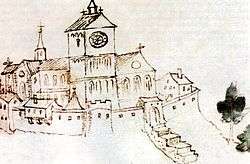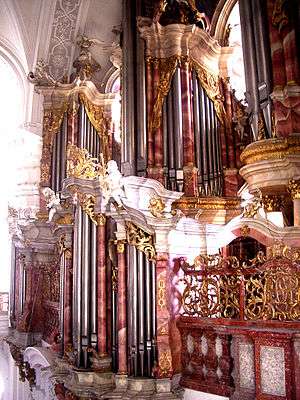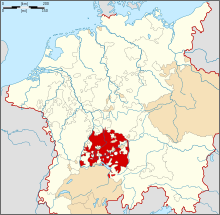Weingarten Abbey
Weingarten Abbey or St. Martin's Abbey (German: Reichsabtei Weingarten until 1803, then merely Abtei Weingarten) is a Benedictine monastery on the Martinsberg (St. Martin's Mount) in Weingarten near Ravensburg in Baden-Württemberg (Germany).
Imperial Abbey of St Martin at Weingarten Reichsabtei Weingarten | |||||||||
|---|---|---|---|---|---|---|---|---|---|
| 1274–1803 | |||||||||
 Coat of arms of Weingarten
| |||||||||
 Weingarten Abbey, 1525 | |||||||||
| Status | Imperial Abbey | ||||||||
| Capital | Weingarten | ||||||||
| Government | Theocracy | ||||||||
| Historical era | Middle Ages | ||||||||
• Founded | 1056 1274 | ||||||||
1268 | |||||||||
• Gained Reichsfreiheit | 1274 | ||||||||
• Joined Council of Princes | 1793 | ||||||||
| 1803 | |||||||||
• Annexed by Württemberg | 1806 | ||||||||
| |||||||||
| Today part of | |||||||||


First foundation
In 1056, Welf I, Duke of Bavaria, founded a Benedictine monastery on the Martinsberg, overlooking the village of Altdorf, an inheritance from his mother. The name Weingarten (vineyard) is documented from about 1123. (In 1865, the village took the name of the monastery to become the present town of Weingarten). He settled it with monks from Altomünster Abbey. In 1126, Henry IX, Duke of Bavaria, withdrew here after his abdication; he died the same year and was buried in the abbey church.
The monks worked, among other things, at manuscript illumination. Their most famous work is the Berthold Sacramentary of 1217, now in the Pierpont Morgan Library in New York City. Also of especial note is the Welfenchronik, written and illustrated in about 1190, chronicling and glorifying the House of Welf which had its seat at Ravensburg nearby.
The monastery was elevated to the status of a Reichsabtei, independent of all territorial lordship except that of the emperor, in 1274.
It acquired territory of 306 km2 (118 sq mi), stretching from the Allgäu to the Bodensee and including many forests and vineyards, and was one of the richest monasteries in southern Germany.
From 1715, the Romanesque abbey church, constructed between 1124 and 1182, was largely demolished, and replaced between 1715–24 by a large and richly decorated Baroque church, which since 1956 has been a papal basilica minor. This church was intended to stand within a monastic site built to the ideal layout, but this undertaking was only partially completed as the north wing would have blocked the via regia or imperial road. Following the order on April 27, 1728 to stop construction on the north wing, the southern wing was extended and the east wing was completed.
In 1803, during the German Mediatisation, the abbey was dissolved. At first, it became part of the Principality of Nassau-Orange-Fulda, and then in 1806 part of the Kingdom of Württemberg. The buildings were used inter alia as a factory and as a barracks.
Second foundation
In 1922, Weingarten was re-founded and re-settled by Benedictines from Beuron Archabbey and from the English Abbey of Erdington (in a suburb of Birmingham) which had itself been settled from Beuron. In 1940, the monks were expelled by the National Socialists, but were able to return after the end of the war.
The monks are responsible for the management of the "Blutritt", or pilgrimage to the Reliquary of the Holy Blood in the abbey church; they also run a guesthouse.
Weingarten belongs to the Beuronese Congregation of the Benedictine Confederation. It is a monastery of two ecclesiastical traditions or rites — one part of the monks follow the Roman Rite, the other part the Byzantine.
In 2009 only four monks remained in Weingarten. The abbey was vacated on October 16, 2010; the Catholic Diocese of Rottenburg-Stuttgart stepped in as a new tenant and tried to find a new monastic community to install here.
In 2014, the Diocese offered the rooms to the State of Baden-Württemberg as a refugees home. Due to dilapidated sanitary installations and issues of monument protection this was declined at first; instead parts of the rooms used by the Academy of the Diocese of Rottenburg-Stuttgart (see below) were rededicated as refugees home. In 2015, the number of refugees rose steeply. In July and August 2015 a part of the former abbey rooms was cut off and prepared to serve as additional Bedarfsorientierte Erstaufnahmeeinrichtung (BEA) (auxiliary first admittance/initial reception facility for refugees). At end of October 2015 about 130 refugees[1] were accommodated there and about 40 at the refugee home in the rooms of the Academy.[2]
Buildings

The abbey and the St. Martin's Basilica are a major attraction on the tourist route known as the Oberschwäbische Barockstrasse (Upper Swabian Baroque Route).
The current church was built between 1715 and 1724 in the Italian-German Baroque style according to plans by Franz Beer, with magnificent Cosmas Damian Asam's frescoes.[3] The church is the second largest church in Germany,[4] and is the largest Baroque church in Germany. The 102 meter long church is known as the "Swabian St. Peter's" since this church is almost exactly one-half the size of St. Peter's Basilica in Rome.[5]
Within the church is the famous Gabler Organ, a church organ that was built between 1735 and 1750 by Joseph Gabler. The organ has over 60 registers, 169 ranks, 63 voices[6] and over 6600 pipes.[5]
A wing of the abbey precincts accommodates the present monastery. Other parts of the former abbey house the Pädagogische Hochschule Weingarten and the Academy of the Diocese of Rottenburg-Stuttgart.
Relic of the Holy Blood of Jesus

The greatest treasure of Weingarten was its famous relic of the Precious Blood, still preserved in the church of Weingarten. Its legend runs thus: Longinus, the soldier who opened Jesus's side with a lance, caught some of the Sacred Blood and preserved it in a leaden box, which later he buried at Mantua. Being miraculously discovered in 804, the relic was solemnly exalted by Pope Leo III, but again buried during the Hungarian and Norman invasions. In 1048 it was re-discovered and solemnly exalted by Pope Leo IX in the presence of the emperor, Henry III, and many other dignitaries. It was divided into three parts, one of which the pope took to Rome, another was given to the emperor, Henry III, and the third remained at Mantua. Henry III bequeathed his share of the relic to Baldwin V, Count of Flanders, who gave it to his daughter Juditha. After her marriage to Welf I, Duke of Bavaria, Juditha presented the relic to Weingarten. The solemn presentation took place in 1090, on the Friday after the feast of the Ascension, and it was stipulated that annually on the same day, which came to be known as Blutfreitag, the relic should be carried in solemn procession.
The procession was prohibited in 1812, but since 1849 it has again taken place every year. It is popularly known as the Blutritt. The relic is carried by a rider, der heilige Blutritter, on horseback, followed by many other riders, and many thousands of people on foot. The reliquary, formerly of solid gold, set with numerous jewels, and valued at about 70,000 florins, was confiscated by the Government at the suppression of the monastery and replaced by a gilded copper imitation.
Abbots of Weingarten
- Alto c. 750-ca. 770 (in Altomünster)
- Marinus
- Etto c. 780
- Gelzo 780-792
- ...
- Rudolf c. 1000-1025
- Eberhard c. 1025-c. 1040
- Heinrich I 1040-c. 1070 (move to Weingarten 1055)
- Beringer c. 1070-c. 1080
- Adilhelm of Luxemburg c. 1080-c. 1088
- Walicho c. 1088-c. 1108
- Kuno Truchseß of Waldburg-Thann c. 1109-1132
- Arnold c. 1133-c. 1140
- Gerhard Truchseß of Waldburg-Thann c. 1141-c. 1149
- Burkhard c. 1149-c. 1160
- Dietmar of Matsch c. 1160-c. 1180
- Marquard of Triberg c. 1180-c. 1181
- Werner of Markdorff c. 1181-c. 1188
- Saint Meingoz of Lechsgemünd c. 1188-1200
- Berthold of Heimburg 1200-1232
- Hugh de Montfort 1232-1242
- Konrad I of Wagenbach 1242-1265
- Hermann of Biechtenweiler 1265-1299
- Friedrich Heller von Hellerstein 1300-1315
- Konrad II von Ibach 1315-1336
- Konrad III von Überlingen 1336-1346
- Heinrich II von Ibach 1346-1363
- Ludwig von Ibach-Heldenberg 1363-1393
- Johann I von Essendorf 1393-1418
- Johann II Blaarer von Guttingen und Wartensee 1418-1437
- Erhard von Freybank 1437-1455 (d. 1462)
- Jobst Penthelin von Ravensburg 1455-1477
- Kaspar Schieck 1477-1491
- Hartmann von Knorringen-Burgau 1491-1520
- Gerwig Blarer von Görsperg 1520-1567
- Johann III Halblizel 1567-1575
- Johann Christoph Rastner von Zellersberg 1575-1586 (d. 1590)
- Georg Wegelin 1586-1627
- Franz Dietrich 1627-1637
- Domenicus I Laumann von Liebenau 1637-1673
- Alfons von Stadelmayer 1673-1683
- Willibald Kobold 1683-1697
- Sebastian Hyller 1697-1730
- Alfons II Jobst 1730-1738
- Placidus Renz 1738-1745 (d. 1748)
- Domenicus II Schnitzer 1746-1784
- Anselm Ritter 1784-1803
New foundation:
- Ansgar Höckelmann 1922–1929, † 1943
- Michael von Witkowski 1929-1933, † 1945
- Conrad Winter 1933–1953, † 1957
- Wilfrid Fenker 1953–1975, † 1975
- Dr. Adalbert Metzinger 1975–1982, † 1984
- Dr. Lukas Weichenrieder 1982-2004
- Archabbot Theodor Hogg of Beuron, Abbot-Administrator 2004-2007
- P. Basilius Sandner, Prior-Administrator 2007-2009
- Dr. Albert Schmidt, Abbot-Administrator 2009–2010
Other burials
- Welf II, Count of Swabia
- Welf I, Duke of Bavaria
- Judith of Flanders, Countess of Northumbria
- Welf II, Duke of Bavaria
- Wulfhilde of Saxony
See also
Notes
- "Official occupancy rates for the district of Tübingen (regularly updated)" (PDF).
- Cameo Magazin No.2 (in German): Letters written by the refugees in Weingarten
- Weingarten Basilika
- Michael Ott (1913). . In Herbermann, Charles (ed.). Catholic Encyclopedia. New York: Robert Appleton Company.
|access-date=requires|url=(help) - City of Weingarten (in German) accessed August 25, 2008
- The Worlds Largest Organs accessed August 25, 2008
References
![]()
- Michael Heinlen, An Early Image of a Mass of St. Gregory and Devotion to the Holy Blood at Weingarten Abbey, Gesta, Vol. 37, No. 1 (1998), pp. 55–62
External links
| Wikimedia Commons has media related to Kloster Weingarten. |
- (in German) Pädagogische Hochschule
- (in German) Academy of the Diocese of Rottenburg-Stuttgart
- (in German) Klosterfestspiele

